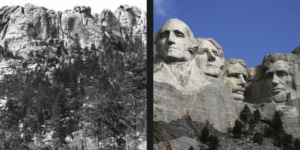 NICK ESTES, nicholas.w.estes at gmail.com, @nick_w_estes, @The_Red_Nation
NICK ESTES, nicholas.w.estes at gmail.com, @nick_w_estes, @The_Red_Nation
Estes is an assistant professor of American studies at the University of New Mexico. He is a citizen of the Lower Brule Sioux Tribe and host of the Red Nation podcast. His latest book is Our History is The Future.
He was on “Democracy Now!” Monday morning, noting that while Trump talks about preserving history, protestors were just arrested for asserting history and standing for treaties at Mount Rushmore. One protestor, Nick Tilsen, is still being held. Estes also addressed the impact of the pandemic on native people in the U.S. and the toppling of a Christopher Columbus statue in Baltimore.
Bloomberg Law reported Monday: “Dakota Access Oil Line to Be Shut by Court in Blow for Trump.” Estes is co-editor of Standing with Standing Rock — see an in-depth interview with Estes on “Flashpoints” last year.
He notes the sculptor of Mount Rushmore, Gutzon Borglum, also created the Confederate memorial at Stone Mountain in Georgia.
Estes recently appeared on the podcast Intercepted, stating that colonialism revolves around “God, gold, and glory,” noting: “Mount Rushmore is named after a gold prospector who had illegally entered into Lakota treaty territory to begin prospecting. … The Black Hills [where Mount Rushmore is located] were also a place of origin and a place of cultural and spiritual significance for over 50 Indigenous nations.”
George Washington “was known as ‘town destroyer.’ He was given that name by the Haudenosaunee Confederacy because he led a scorched-earth campaign against the Haudenosaunee prior to the Revolutionary War, but also during the Revolutionary War, to push them further westward. …
“Thomas Jefferson was really the architect of Indian removal as we now know it, like the Trail of Tears or the removal of the southeastern tribes from what we now know as the South, places like Georgia and North Carolina. But he was the one who really envisioned that, and that’s why he facilitated something like the Louisiana Purchase, because he imagined moving — basically creating a large Indian reserve — west of the Mississippi River. And of course, that, later on, became Oklahoma Territory. He also envisioned that the entire western hemisphere would be dominated” by Anglo-Saxons and “this was really the foundation of what we know as Manifest Destiny. …
“Lincoln himself is a very controversial figure for our people because he signed the death sentence for 38 Dakota patriots who took up arms against the United States after a breakdown in treaty obligations happened during the Civil War. … In 1862, you had the passage of the Homestead Act. … Dakota Uprising, as it’s known [happened] in 1862 … because the United States failed to live up to its treaty obligations to the Dakota people and … they took up arms. … But as the state of Minnesota reorganized itself for retaliation, they began organizing these irregular settler militias that were composed” of “recent European immigrants to basically create what we now know as the National Guard to crush the Indigenous uprising.”
The fourth face blasted into the mountain is that of “conservationist” Theodore Roosevelt. He is known for his role in the Spanish-American War with the “Rough Riders” and then for “gunboat diplomacy” during his presidency. Estes notes that even his role as “preservationist” is an ominous one for native people since “for settlers to appreciate nature, Indigenous people had to be ‘removed’ from nature.”
Estes notes that with respect to Minneapolis: “Leading up to the uprising and the killing of George Floyd, the conversation that I was hearing on the ground there, not just from Indigenous people but all people in that community … was the question of housing because housing prices were skyrocketing. So the intensification of police violence always correlates with profound inequality and we can trace that inequality in a place like Minneapolis back to its colonial origins when they expelled my ancestors.”
Intercepted played audio of Russell Means of the American Indian Movement: “And originally AIM, of course, was organized to combat police brutality in Minneapolis, Minnesota. But it grew, because the ideas of self-determination, the idea of being able to stand on your own two feet, eye-to-eye with the white man and say, ‘Wait a minute. Stop.'”
